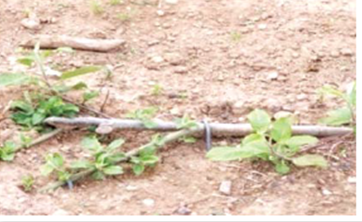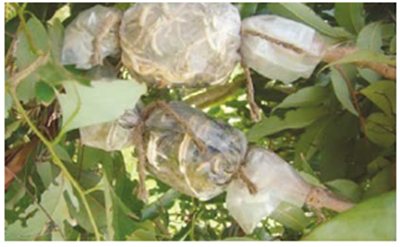| Propagation through layering |
- In this technique a vegetative branch is made to root while it is still attached to the mother plant.
- The rooted branch will be later excised and planted as a new seedling.
- Different layering techniques such as air layering techniques such as air layering, mound layering and serpentine layering are commonly practiced
|
| Air layering |
Air layering is carried out as follows
- Pencil size shoot of the current years growth is to be selected
- On the selected shoot, preferably on the basal portion, a ring of bark is removed and the exposed wood is scraped.
- The exposed portion is further wrapped with moist inert rooting medium like Sphagnum moss, moist coir etc.
- And covered with a polythene sheet making it air tight
- This branch is left undisturbed on the mother plant for about 2-8 weeks depending on the species
|

|
During the course several adventitious roots emerge from the base of the exposed bark, which is covered
- The rooted branch will be later cut below the covered portion and planted as a separate seedling
|
|
Rooting in Air Layer |
Air Layer Ready for Planting |
In the case of medicinal plants, air layering is frequently followed in Goose berry (Amla), Tamarind (Chinta) and Ficus spp
|
| Mound layering |
It is another technique of layering and carried out as follows:
- A long and supple branch is selected
- Ring of bark is removed at the base and buried in the soil
- In the due course, roots emerge from the buried portion
- After sufficient emergence of the roots the branch will be separated from the mother plant and planted as an independent plant
 |
 |
Trenching Layering |
Multiplication of Rootstock through Mound Layering |
- A series of such layering done on a single long branch that is buried and exposed alternately makes serpentine layers
- Serpentine layering can be tried for species, which have drooping long and supple branches.
- In the case of medicinal plants, serpentine layering is seen in very few species such as Tinospora cordifolia (Jivantika, Tippatiga), Celastrus paniculatus (Gundameda, Pallerutiva)
|
|





